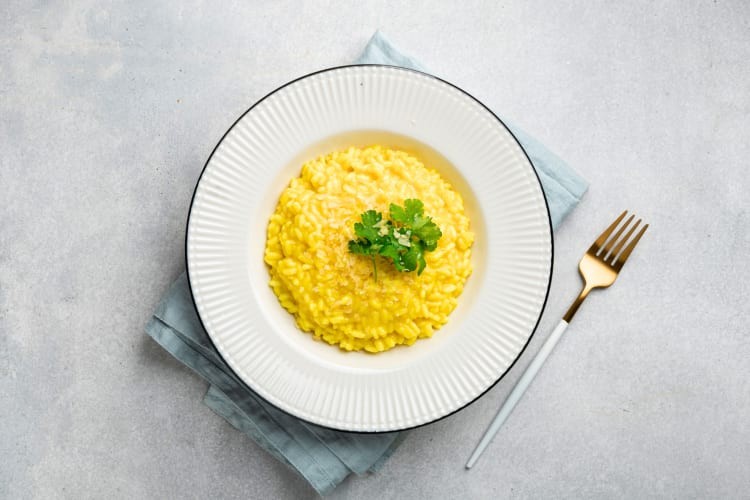Milan, the capital of Lombardy in Northern Italy, is celebrated for its fashion, art, design, and culture. Beyond its stylish reputation, Milan is also a culinary hub offering a unique gastronomic experience. Forget the typical pasta-and-tomato sauces; Milanese cuisine boasts hearty, flavorful dishes that reflect the region’s rich agricultural heritage and proximity to other European culinary influences.
Whether you’re planning a trip to Milan, eager to host a Milanese-themed dinner, or simply curious about exploring new flavors, discovering the iconic food of Milan will enrich your culinary knowledge and travel plans.
A Deep Dive into Traditional Milanese Dishes
Here are 12 of the most traditional Milanese dishes that define the city’s unique culinary identity:
1. Minestrone alla Milanese
Unlike the pasta-centric minestrone found elsewhere in Italy, Milan’s version swaps pasta for rice. Minestrone alla Milanese is a vibrant vegetable soup featuring cabbage, spinach, celery, and a variety of seasonal vegetables cooked in a rich broth. This hearty and comforting soup is enjoyed both hot in winter and chilled in summer, showcasing the versatility of Milanese cuisine.
2. Risotto alla Milanese
Risotto is popular across Italy, but Risotto alla Milanese holds a special place in Milanese cuisine. The dish’s signature golden hue comes from saffron. Parmesan cheese and butter add to its creamy texture. The process involves toasting white rice, covering it with white wine, and then cooking it in beef stock until al dente. Saffron is added at the end. Risotto alla Milanese is a traditional side dish perfect with various entrees.
3. Ossobuco
Ossobuco, meaning “bone with a hole,” refers to a cross-cut shank braised with vegetables. The dish features a slice of shin bone surrounded by tender meat. Ossobuco is typically braised in white wine, onions, celery, and carrots. A garnish of gremolata, made from parsley, garlic, and lemon zest, adds bright and fresh flavors. This hearty dish is often served with polenta or risotto alla Milanese.
4. Polenta
Polenta, a staple in Northern Italy, is traditionally made from boiled cornmeal. Similar to Southern American grits but made with yellow corn, polenta offers a mild flavor and creamy consistency when finished with butter and cheese. It can be served as a side dish or enjoyed as a breakfast porridge with nuts, honey, or maple syrup.
5. Gorgonzola
Gorgonzola, named after a town near Milan, is a celebrated blue cheese. Made from unskimmed cow’s milk, it comes in various textures, from firm to creamy. Gorgonzola’s distinct blue-green veins differentiate it from other blue cheeses. The dolce version is sweet and creamy, while the piccante is spicy. Enjoy gorgonzola on sandwiches, cheese boards, or melted into sauces.
6. Panettone
Panettone, a sweet, cake-like bread, is particularly popular during the holidays. Made with a simple dough of butter, eggs, yeast, and flour, it often includes raisins and candied fruits. Traditionally dome-shaped and tall, panettone pairs well with prosecco, coffee, hot chocolate, or eggnog. It is so valued that Milan requires all panettone to be made with natural yeast.
7. Piadina
Piadina is a thin, crispy Italian flatbread prepared with flour, water, and olive oil. Without yeast, this flatbread is filled with meats, cheeses, and vegetables like spinach, mozzarella, and prosciutto. Some variations even feature sweet fillings like jam or Nutella. Piadina is a popular lunch option that is easy to eat on the go.
8. Busecca
Busecca, also known as trippa alla Milanese, is a hearty stew made with tripe (cow or sheep stomach lining), beans, vegetables, tomato puree, and broth. Considered “peasant cuisine,” busecca offers a rich and adventurous flavor profile. The name comes from “butze,” which has German origin and refers to “guts.”
9. Cassoeula
Cassoeula is a robust pork and cabbage stew popular during the colder months. Made with sausage and various parts of the pig, this dish is traditionally eaten on January 17th, the feast day of Saint Anthony the Abbot, the patron saint of livestock breeders. It is also served on All Soul’s Day, November 2nd.
10. Cotoletta alla Milanese
Cotoletta alla Milanese, or Veal Milanese, is similar to Wiener Schnitzel. The Milanese version uses loin meat. This breaded veal cutlet is fried in butter and can be prepared with or without the bone. It can be pounded thin and crispy or cooked thick. It is best served with risotto or a simple salad.
11. Busecchina
Busecchina is a dessert originating from Lombardy and Piedmont, perfect for autumn. This dish combines dried chestnuts, water, and sweet wine. Once softened, the mixture is served with cream, the cooking liquid, whipped cream, and cinnamon. Busecchina was traditionally made for Saint Savina festivities on January 31st and originally included meat instead of chestnuts.
12. Mondeghili
Mondeghili, also known as polpette, are Milanese meatballs made with ground beef, salami, sausage, mortadella, eggs, cheese, garlic, herbs, and spices. Rolled into balls, coated in breadcrumbs, and fried in butter, these meatballs are typically served as an appetizer, sometimes in tomato sauce. Mondeghili began as “povera cucina,” utilizing leftover ingredients.
Embrace Milan’s Unique Culinary Landscape
Milanese cuisine stands out for its focus on meat, hearty stews, and unique ingredients. While tomatoes are less common than in Southern Italy, Milanese food draws culinary inspiration from neighboring Austria and France, leading to diverse and rich culinary offerings. For food enthusiasts seeking new tastes, Milan’s culinary scene promises a delightful adventure.

